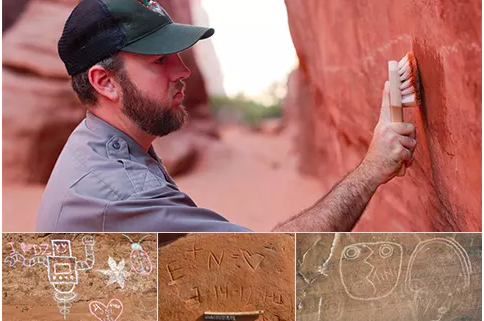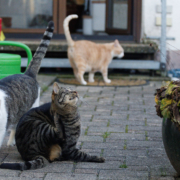Making sense of graffiti and street art in local, state, and national parks
Graffiti and street art can be found in most big cities and urban environments, and on almost any type of surface. One of the less acknowledged and academically studied places where graffiti and street art exist are the numerous local, state, and national parks. These range from comparatively small areas that local governments set aside for the public use located in urban environments (e.g., the small pocket parks spread throughout a city like Washington, DC), to large swaths of land, with different types of flora, and fauna, topography, and sometimes including ancient priceless American-Indian carvings, etchings, pictographs, and petroglyphs that encompass several states (e.g., Yellowstone National Park).
What does graffiti and street art in local, state and national parks look like?
The majority of graffiti that appears in these locations are tags, a moniker of sorts, typically done with white or black indelible marker pens on the front or back of “man-made” signs, posts, and culverts. Occasionally, numerous statues, memorials, and plaques are covered with graffiti. This kind of visual resistance appeared to increase during the Black Lives Matter protests, in the spring and summer of 2020 as a reaction to the death of George Floyd, an unarmed African-American man, at the hands of a white Milwaukee police officer.
Frequently there’s also lots of tagging inside the public restrooms (at least the men’s room), including porta potties that are located near the parking lots of these parks. Sometimes the tagging is more complicated, with cartoon like images. If there are train tracks or logging roads, running through the park, there may be tagging on the tracks or on low level rocks. Graffiti may also include letters, words, and images that are carved, chalked, chiseled. or scratched, on to trees and rocks. In terms of street art, the most frequent medium are stickers. On rare occasions will larger graffiti pieces, some with bubble letters, will be placed on rock surfaces.
Why is graffiti and street art that appears in local, state and national parks rarely studied?
In general, there is less graffiti and street art in local, state and federal parks, then the walls, doors, transportation systems, and back alleys of major metropolises. A number of reasons probably exist that explain why this occurs:
• With the exception of local parks, those inclined to engage in graffiti and street art rarely visit state and national parks, or they may not have the motivation to participate in this kind of activity in these areas.
• Implicit norms shared by taggers, writers and artists. Just like, the infrequent graffiti and street art left on houses of worship (i.e., churches, mosques, synagogues, and temples), the natural environment is often considered to be sanctified and out of bounds for writers and artists to leave their mark. Unlike private (and commercial space), it’s frequently assumed that local, state, and federal parks have been set aside as protected areas to be enjoyed by all, and thus writing graffiti or street art is perceived as taboo, among graffiti and street artist community.
Why might academics refrained from studying graffiti and street art in local, state and national parks?
A handful of reasons possibly explain why academics have not produced much scholarship on graffiti and street art in local, state and federal parks. This includes:
• It may not be perceived to be that interesting.
• There is less graffiti and street art in these locations. Thus,
• It may not be considered to be that big a social problem.
• Access to relevant data is resource-intensive. Unless we are talking about city parks, and unlike graffiti and street art that is put up in big cities, perpetrators rarely live near state and federal parks Notwithstanding traveling to these places is costly, based on my experience, the National Park Police and National Park Service Police do not readily share data about this kind of vandalism with qualified researchers.
How might researchers study this subject?
Moving forward, there are some possible ways to consider tackling this subject.
Since getting interviews with people engaging in graffiti and street art in local, state and federal parks is extremely difficult, researchers might start by reviewing popular news media accounts of graffiti and street art in these locations.
Alternatively investigators might try to secure interviews (or even administer surveys) with rank and file National Park Police, National Park Service Rangers, service personnel, and volunteers who may pick up trash, and help to maintain or cut trails, and visitors.
Another tactic may be a visual ethnography where over a significant period of time, an inventory of graffiti and street art is taken in selected parks, to determine its breadth, frequency, and types.
These methods may enable us to get a better sense of what kinds of graffiti and street art occur in these locations, where it is located, its content, how widespread it is, who is engaging in this activity and how agents of social control are responding to it.
Although the amount of graffiti and street art that appears in local, state, and national parks pales in comparison to that which is typically present in large urban settings, its study may enable us to have a better picture about the depth and breadth of this phenomenon and the people who engage and respond to this activity.
Photo credit:
National Park Service Photos
Chalking, carving, and scratching are all types of graffiti. Depending on the damage, it may take a significant amount of work to remove.












